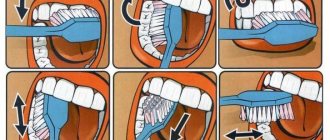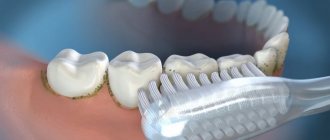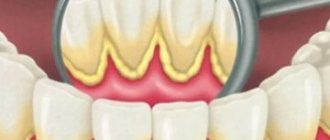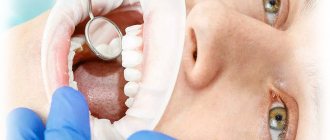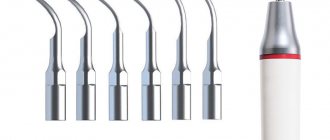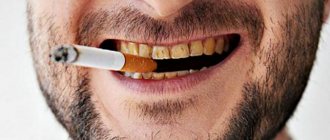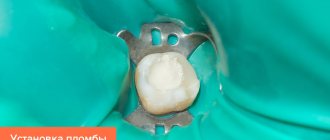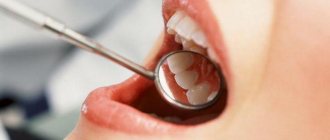The main method of preventing dental diseases is high-quality hygienic teeth cleaning. Cleaning the oral cavity should be carried out daily at home and twice a year at a professional level in the dentist's chair. You can carry out high-quality removal of plaque on teeth using various methods at Beryozka dentistry. The clinic employs qualified specialists with extensive experience. Doctors will remove all dental plaque, diagnose diseases, and select individual hygiene products.
Why does tartar appear?
The cause of tartar formation in children and adults, in most cases, is poor hygiene or an unhealthy environment in the oral cavity. After eating, crushed food debris mixes with saliva and bacteria to form plaque on the surface of the teeth. It can be easily removed with toothbrushes or floss if done in a timely manner. If teeth cleaning is not carried out regularly, and the composition of our saliva is disturbed, then over time the usual yellow plaque hardens, turning into mineralized deposits, which can only be removed with the help of special devices for removing tartar.
Depending on the location in relation to the gum, supragingival and subgingival tartar are distinguished. Supragingival is easy to detect on your own during examination. It is a yellow or brown clay-like consistency that can be removed with a special tool. The main places for the formation of such a stone are in the area of active salivation. Subgingival calculus has a hard base that is dark brown or greenish-black in color. It can only be detected by gum recession or with the help of a probe. The formation of subgingival deposits is possible on any tooth, regardless of the distance of the salivary glands.
Why is fluoridation needed?
Cleaning the dentition from tartar may be accompanied by exposure of the dentinal tubules, and this, in turn, leads to increased tooth sensitivity. To prevent increased sensitivity, fluoridation is carried out - treating the enamel with a gel with an enamel-sealing substance based on copper hydroxide (applied using a tampon).
Techniques used:
- Simple fluoridation - placing a mold with a special solution on the jaw
- Deep fluoridation - applying F-containing varnish separately to each tooth
To achieve a lasting result, it is recommended to repeat the procedure three times at intervals of 1-2 weeks.
To prevent caries, it is recommended to take a course of 10-14 procedures.
Why is tartar dangerous?
The formation of dental plaque, and then tartar, is possible for various reasons: the involvement of only one side of the jaw, left or right, in chewing; dietary habits, in particular, eating only soft foods; salt imbalance in the body; using low-quality toothbrushes; crooked teeth; smoking. And some people have a congenital predisposition to the appearance of stones. In such cases, even regular care does not guarantee the safety of teeth.
Microbes, which make up 95% of plaque, form acid during their life processes, which, due to tartar, cannot be neutralized by the alkaline environment of the oral cavity. As a result, the enamel is gradually destroyed, and a favorable environment for the formation of caries is formed. Tartar also negatively affects the gums - located between the gum and the tooth, it becomes overgrown with new plaque, which in turn penetrates the gums and causes inflammation. This creates an unpleasant odor in the mouth, gingivitis develops, and with further neglect, periodontitis.
Probability and causes of complications
Like any other dental intervention, ultrasonic cleaning can lead to undesirable consequences. Complications may be associated with:
- increased sensitivity of the gums (irritation or bleeding);
- mechanical thinning of tooth enamel as a result of previous procedures using aggressive polishing pastes;
- using an outdated installation (previously less gentle attachments were used);
- low qualification of the dentist.
Methods for removing tartar
How to remove tartar? Naturally, this should be done exclusively in a dental office. Previously, tartar cleaning was done mechanically, using special hooks. Subsequently, they decided to abandon this method. Firstly, it was not painless, and secondly, it was not effective, and damage to the tooth and gums could occur. This caused a lot of problems in the treatment and prevention of periodontitis in children and adults. Currently, there are two ways to remove tartar: laser and ultrasonic tartar removal.
Ultrasound
Ultrasound removal of tartar is a new technology in the fight against fossils on teeth, which effectively gives a 100% result in cleaning teeth and gums. However, it must be used with extreme caution in case of cardiovascular diseases and is strictly prohibited if you have a pacemaker. How to get rid of tartar using ultrasound? It's quite simple. An ultrasonic scaler causes vibrations and vibrations of a certain frequency, with the help of which the tooth surface is carefully cleaned of fossils without damaging the tooth. Thanks to the cavitation effect (strong turbulence of the liquid), contact of the device nozzle with the tooth is prevented.
Moreover, when removing tartar with ultrasound, oxygen is released from the water, which disinfects the treated area. In addition, mechanical cleansing of the root and gum occurs. The entire process is absolutely bloodless and painless; only in cases of high sensitivity, tartar removal is carried out using an anesthetic gel.
Laser
Lasers are also used against tartar, but this method is not as popular as ultrasound. The principle of operation of the laser is similar to the removal of tartar using ultrasound and is aimed at crushing fossilized deposits into small parts. However, a laser machine is several times more expensive than ultrasound equipment, so not many clinics will be ready to offer it to you.
Air Flow abrasive treatment
The principle of the Air Flow method is to apply a solution under pressure, which contains water and abrasives, to the teeth. The mixture is applied to the teeth under pressure and, as a result of air-abrasive treatment, the surface of the teeth is cleaned of yellow plaque and surface pigmentation. The method is used as an auxiliary procedure after removing tartar with ultrasound. Air abrasive treatment removes its residues in hard-to-reach areas, the enamel is ground and polished. The Air Flow technique can also be effective as an independent procedure, but only in the fight against stone formations in the initial stages.
Chemical etching
Etching is used as an auxiliary technique in the same way as air abrasive processing. Chemical exposure is carried out using acids or alkalis, which allows you to dissolve or soften tartar, facilitating its further removal. Today this technique is practically not used.
When should you not brush your teeth with ultrasound?
Despite the atraumatic and highly safe method, ultrasonic cleaning has its contraindications. You will have to choose another method in the following cases:
- with increased tooth sensitivity;
- in the presence of complex orthopedic structures, including braces;
- in the presence of implants;
- patients with tuberculosis and autoimmune diseases;
- during the period of change of bite in children.
It is not recommended to carry out this procedure in the first trimester of pregnancy, with respiratory diseases, or in a state of acute cold.
Prevention of tartar
Tartar appears after the formation of yellow plaque on the teeth, so various ways to combat it will be prevention. The main thing here is safety! Toothpaste can be used as an affordable preventative against tartar. Fluoride-containing and whitening toothpastes are suitable. The former have relatively safe abrasiveness, due to which it is possible to effectively remove plaque. But due to the possibility of damage to the enamel, this product cannot be used constantly. As an alternative, you can buy an ultrasonic brush, which removes plaque quite effectively, which means it is a good prevention of tartar. Fluoride-containing toothpastes, in turn, are biologically active and can increase the resistance of teeth to caries, which is very important if they are prone to the formation of tartar. Using ultrasonic brushes and the best irrigators can also help combat simple deposits. The correct mouth rinse, which contains potassium citrate, will also prevent the formation of tartar.
Traditional medicine offers alternative methods of prevention in the fight against tartar. Raw hard fruits and vegetables such as black radishes, apples, carrots and radishes remove plaque naturally. A decrease in the formation of tartar has also been noted in people who consume lemon, birch sap and peas. Measures to remove tartar at home, such as the use of sand, soda and salt, are ineffective. They are strictly not recommended, as they can cause irreparable damage to tooth enamel. In general, removing tartar using folk remedies should be treated with great caution.
The use of pastes, special brushes and folk remedies to prevent the appearance of tartar will, of course, be beneficial. But only a dental hygienist can remove large and complex formations. Experts strongly recommend that absolutely everyone undergo professional hygienic cleaning twice a year. This is partly due to the fact that on average it takes about six months to form tartar. Regular visits to the hygienist’s office are the most reliable way to prevent not only dental plaque, but also diseases such as caries, gingivitis and periodontitis. Don't forget that dental treatment is much more expensive than the cost of professional oral hygiene from a hygienist.
Cleaning teeth with a sandblaster (Air-Flow method)
Thanks to this method, you can gently and without consequences remove soft deposits (but not a lot of tartar!), and also lighten the enamel by 0.5 tones (relevant for smokers and coffee lovers). The meaning of the device is very simple - an abrasive (usually based on soda) is poured into a special flask. Water enters there (into the flask), and this entire mixture, under high pressure, cleans off all the deposits.
Advantages:
- The technology allows you to clean the most inaccessible corners of the oral cavity (for me personally, cleaning the interdental spaces with this method brings great joy. A sandblasting machine cleans in a way that no other machine can do).
- The ability to soften any deposits and particles of tartar, as well as remove plaque and age spots.
- Speed of implementation - in standard cases it will take up to 30 minutes.
- Comfort and painlessness. There are times when this method causes discomfort. But you and I can easily cope with it, thanks to additional recommendations.
- Safety - the device does not damage enamel and gums, and the natural components of polishing powders do not cause harm.
- Additional polishing of tooth enamel - abrasive particles eliminate roughness and smooth the surface of the teeth.
- Gum massage is an additional effect of the procedure, which improves blood supply and metabolic processes in soft tissues.
- Ability to clean braces, implants and other orthopedic structures.
Flaws:
- The main disadvantage of sandblasting is that it does not remove massive mineralized formations (tartar). The device only removes pigmented plaque and soft bacterial deposits well, and does a much worse job even with small tartar.
How much does tartar removal cost?
The price of the procedure for removing tartar with ultrasound or laser is usually included in the cost of the complex, called professional hygiene. Some clinics set a total price for hygienic cleaning of the entire oral cavity, and some set a general price for the treatment of one tooth. So, in Moscow, the price for cleaning one tooth, including removing tartar from it, ranges from 50 to 500 rubles, that is, the cost of the entire procedure, depending on the number of teeth and the category of the clinic, will vary from 1,400 to 16,000 rubles and more .
Should I remove tartar? For people who care about the health of their teeth, the answer to this question will be clear. Tartar should be removed in the same way as brushing your teeth and removing thick plaque on the tongue. And, of course, we must not forget about professional oral hygiene. Remember that by coming to a specialist on time, you are laying a healthy foundation for your health without leaving a single stone on your teeth.
Ultrasound cleaning and pregnancy: what's the problem?
Although dental care is especially important during pregnancy, ultrasonic cleaning in the early stages of gestation is strongly not recommended due to the fact that ultrasonic waves, imperceptible to us, can disturb the fetus, causing it discomfort.
In addition, in conditions of unstable hormonal levels characteristic of pregnancy, the procedure can cause swelling and bleeding of the gums
Specialists may refuse ultrasound cleaning to a pregnant woman even at later stages if she has:
- Pacemaker
- Dentures
- A number of diseases (ARVI, diabetes mellitus, epilepsy, bronchitis, asthma, sexually transmitted diseases or cancer)
To avoid unforeseen complications, pregnant women should postpone non-urgent procedures until hormonal levels stabilize; As a rule, the risks of dental manipulation are minimized after the second trimester of pregnancy.
